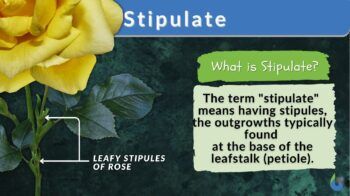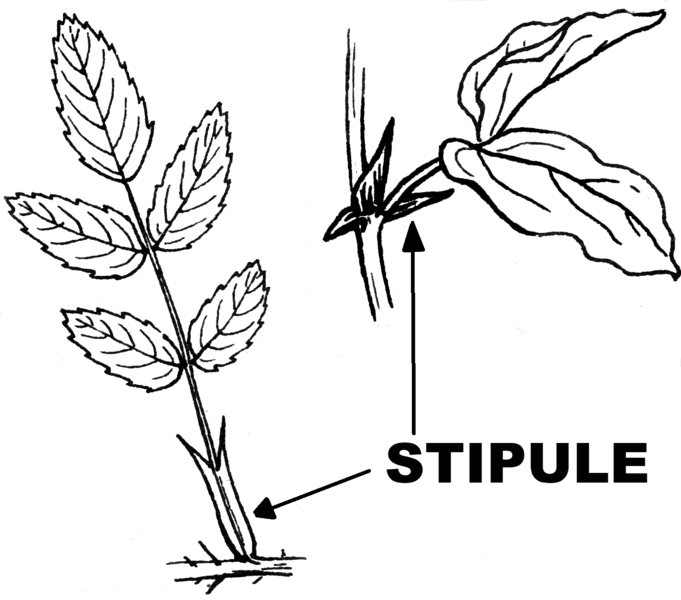
Stipulate
adj., [ˈstɪpjəlɪt]
Definition: Having stipules, such as a leaf with a stipule
Table of Contents
Stipulate Definition
Stipulate meaning: Stipulate typically refers to a specific feature or characteristic of a plant’s leaf. While stipules can be found singly or in pairs depending on the plant species, their position is fixed, i.e. on the base of the petiole. Stipulate leaves can have stipules in varied sizes, shapes, and textures.
When we discuss the leaf anatomy, we study stipules as a “part of the leaf” of an angiosperm plant.

Watch this vid about the leaf structure, including the stipule:
Biology definition:
Stipulate (in botany) is a term used to describe the nature of leaf-bearing stipules. Stipules are small outgrowths or prophylls that are typically leaf-like and present on the sides (one or both sides) of the base of a leafstalk, i.e. on the petiole.
Stipulate Etymology:
The word “stipulate” is derived from the word “stipule”. Stipule is further derived from a 17th-century Latin word “stipula” meaning ‘stalk’ or ‘straw’. Carl Linnaeus, also known as the “father of modern taxonomy” coined the term “stipule” from “stipula”.
Nature Of Leaf Based On The Presence/Absence Of Stipules
The presence or absence of stipules makes a difference to the nature of the leaf. While some leaves have significantly noticeable stipule/s, some others have inconspicuous stipule/s and then there’s a third type with no stipules at all.
Based on this, leaves are classified into 2 major categories:
- Stipulate leaves: Leaves where stipules are present; both prominently noticeable and even inconspicuous stipules.
- Exstipulate leaves: Leaves where stipules are completely absent.
General Points About Stipulate Leaves
- Appearance: Stipules make stipulate leaves appear morphologically quite variable. Stipules can be hairlike, glands, laminar structures, scales, and spines.
- Position: The position of stipules can widely vary from one species to another, hence making different stipulate leaves appear distinguished across species.
- Presence: Stipulate leaves can bear stipules on both sides of the petiole (in pair) and only on one side.
- Occurrence of the phenomenon: The stipulate leaves are a more noticeable phenomenon in dicotyledons (dicot plants) amongst all angiosperm plants. Only some monocotyledons (monocot plants) bear stipulate leaves wherein their number is strictly only one per leaf (not in pairs) in contrast to paired stipules in dicot leaves.
- Relationship between the stipulate nature of leaf and stem node: It is a noted finding that most plant species that primarily have trilacunar nodes usually have stipulate leaves while the plant species with unilacunar nodes usually lack stipulate leaves.
- NOTE: When a single stipule covers go all the way around the stem, it is termed as an “ochrea”. Ochrea is derived from the Latin word “ocrea”, meaning “a protective legging”, botanically describing a plant structure that’s formed from the fusion of stipules. Such a structure forms a layer or sheath that completely surrounds the stem. It is a characteristic feature of the family Polygonaceae. It is also studied in palms where it represents the leaf sheath’s extension beyond the petiole insertion.
Different Types Of Stipulate Leaves
There are different types of stipulate leaves based on the different parameters.
-
Based on the Life Duration of Stipules
Stipulate leaves are of different types based on their life duration. Three main types are:
- Stipulate leaves with “caducous stipules”: In such leaves, the stipules fall off before the leaf unfolding happens.
- Stipulate leaves with “deciduous stipules”: In such leaves, the stipules fall off within no time after the leaf unfolding happens.
- Stipulate leaves with “persistent stipules”: In such leaves, the stipules remain attached to the plant.
-
Based on the Position, Shape, and Size of Stipules
Stipulate leaves are of different types based on the position, shape, and size of the stipules present in the plant. Look at the table below to understand different types of stipules that bring variations to the nature of stipulate leaves.
Table 1: Different positions, shapes, and sizes of stipules are described. | |
|---|---|
| Stipule Type | Description |
| Free Lateral | Stipules that are not fused to any other structure and are located on both sides of the leaf stem |
| Adnate | Stipules partially fused to the petiole, with the anterior part remaining free |
| Interpetiolar | Stipules situated between the petioles, creating the impression of a single stipule between each leaf |
| Intrapetiolar | Stipules located in the angle between the stem and petiole, appearing as a unified structure |
| Ochreate | Stipules appearing as a solid tube encircling the stem |
| Foliaceous | Stipules that resemble leaves and participate in photosynthesis |
| Bud Scales | Hard or scaly stipules that protect leaf buds and typically fall off as the leaf unfolds |
| Tendrillar | Elongated and slender stipules used by climbing plants for support |
| Spiny | Long and pointed stipules serve as a defense mechanism against animals |
| Abaxial/Counter | Stipules located on the side opposite to where the leaf attaches to the stem |
Data Source: Akanksha Saxena of Biology Online
What Is An Example Of A Stipulate Plant?
It is essential to remember that stipules are not universal among plants and their presence or absence can be a useful trait for distinguishing and categorizing different species. Over time, stipules have evolved to serve various functions and adapt to diverse habitats, thereby contributing to the survival and success of the plants that possess them.
Some examples of stipulate plants (or better-called plants with stipulate leaves) are:
- Smilax species
- Allamanda species
- Thevetia species
- Swollen-thorn acacias of Central America have spines called “stipular spines”. These are sharp-pointed stipules at the leaf base. Morphologically, they are enlarged and hollowed out making them comfortable houses for stinging ants.
- Pea plant
- Hibiscus plant
NOTE IT!
“Why are leaves stipulated?”
Do you ever wonder why certain plants have stipules, and what roles do these small leaf-like structures play in the plant’s anatomy?
How do stipules provide protection to young leaves and buds, and how do they contribute to the plant’s energy production through photosynthesis? Isn’t it fascinating how stipules aid in water conservation and support the attachment of leaves to the stem at the same time???
The presence of stipules in certain plants serves multiple functions:
- Protection: Stipules act as protective structures. They guard the young leaves and buds against potential damage from environmental factors or herbivores.
- Support: Some stipules provide additional support to the base of the leaf. This reinforces its attachment to the stem. This is particularly important in plants with large or heavy leaves.
- Photosynthesis: In certain cases, stipules are capable of performing photosynthesis. This contributes to the overall energy production of the plant.
- Water Conservation: Stipules can assist in reducing water loss by partially covering the leaf petiole. This creates a barrier that minimizes transpiration.
- Reproduction: In specific plant species, stipules may have roles in reproduction, possibly aiding in seed dispersal.
- Adaptations: Stipules can undergo modifications to fulfill different functions. They can take on the form of tendrils, spines, or protective sheaths depending on the plant’s environmental conditions and the need to deter herbivores.
Stipules aren’t just useful to plants; they are also useful for humans. The variation in shape, size, and other characteristics of stipules can be significant for plant identification and taxonomy for botanists… ☺
Take the Stipulate – Biology Quiz!
References
- Sinnott, E. W., & Bailey, I. W. (1914). Investigations on the phylogeny of the angiosperms. 3. Nodal anatomy and the morphology of stipules. American Journal of Botany, 441-453.
- do Valle Capelli, N., Alonso Rodrigues, B., & Demarco, D. (2017). Stipules in Apocynaceae: an ontogenetic perspective. AoB PLANTS, 9(1), plw083. https://doi.org/10.1093/aobpla/plw083
- Sinnott, E. W., & Bailey, I. W. (1914). Investigations on the Phylogeny of the Angiosperms. 3. Nodal Anatomy and the Morphology of Stipules. American Journal of Botany, 1(9), 441–453. https://doi.org/10.2307/2435043
- Moreau, C., Hofer, J. M., Eléouët, M., Sinjushin, A., Ambrose, M., Skøt, K., … & Ellis, T. N. (2018). Identification of Stipules reduced, a leaf morphology gene in pea (Pisum sativum). New Phytologist, 220(1), 288-299.
- Mikić, A., Mihailović, V., Ćupina, B., Kosev, V., Warkentin, T., McPhee, K., … & Ellis, N. (2011). Genetic background and agronomic value of leaf types in pea (Pisum sativum). Ratarstvo i povrtarstvo/Field and Vegetable Crops Research, 48(2), 275-284.
©BiologyOnline.com. Content provided and moderated by Biology Online Editors.